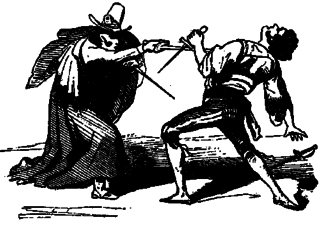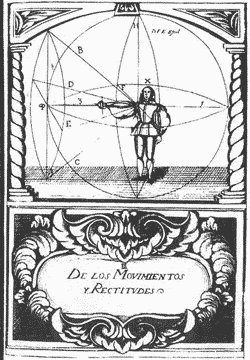
Fencing is a combat sport that features sword fighting. The three disciplines of modern fencing are the foil, the épée, and the sabre ; each discipline uses a different kind of blade, which shares the same name, and employs its own rules. Most competitive fencers specialise in one discipline. The modern sport gained prominence near the end of the 19th century and is based on the traditional skill set of swordsmanship. The Italian school altered the historical European martial art of classical fencing, and the French school later refined that system. Scoring points in a fencing competition is done by making contact with an opponent.

A rapier or espada ropera is a type of sword originally used in Renaissance Spain. The name designates a sword with a straight, slender and sharply pointed two-edged long blade wielded in one hand. It was widely popular in Western Europe throughout the 16th and 17th centuries as a symbol of nobility or gentleman status.

Academic fencing or Mensur is the traditional kind of fencing practiced by some student corporations in Germany, Austria, Switzerland, Latvia, Estonia, and, to a minor extent, in Belgium, Lithuania, and Poland. It is a traditional, strictly regulated épée fight between two male members of different fraternities with sharp weapons. The German technical term Mensur in the 16th century referred to the specified distance between each of the fencers.

A foil is one of the three weapons used in the sport of fencing. It is a flexible sword of total length 110 cm (43 in) or under, rectangular in cross section, weighing under 500 g (18 oz), with a blunt tip. As with the épée, points are only scored by making contact with the tip. The foil is the most commonly used weapon in fencing.

The épée, also rendered as epee in English, is the largest and heaviest of the three weapons used in the sport of fencing. The modern épée derives from the 19th-century épée de combat, a weapon which itself derives from the French small sword.

Swordsmanship or sword fighting refers to the skills and techniques used in combat and training with any type of sword. The term is modern, and as such was mainly used to refer to smallsword fencing, but by extension it can also be applied to any martial art involving the use of a sword. The formation of the English word "swordsman" is parallel to the Latin word gladiator, a term for the professional fighters who fought against each other and a variety of other foes for the entertainment of spectators in the Roman Empire. The word gladiator itself comes from the Latin word gladius, which is a type of sword.

The German school of fencing is a system of combat taught in the Holy Roman Empire during the Late Medieval, German Renaissance, and early modern periods. It is described in the contemporary Fechtbücher written at the time. The geographical center of this tradition was in what is now Southern Germany including Augsburg, Frankfurt, and Nuremberg. During the period in which it was taught, it was known as the Kunst des Fechtens, or the "Art of Fighting". The German school of fencing focuses primarily on the use of the two-handed longsword; it also describes the use of many other weapons, including polearms, medieval daggers, messers, and the staff, as well as describing mounted combat and unarmed grappling (ringen).

The sabre is one of the three disciplines of modern fencing. The sabre weapon is for thrusting and cutting with both the cutting edge and the back of the blade.

Combat reenactment is a side of historical reenactment which aims to depict historical forms of combat. This may refer to either single combat, melees involving small groups, or nearly full-scale battles with hundreds of participants.

The following outline is provided as an overview of and topical guide to fencing:
In fencing, the grip is the part of the weapon which is gripped by the fencer's hand.

The parrying dagger is a category of small handheld weapons from the European late Middle Ages and early Renaissance. These weapons were used as off-hand weapons in conjunction with a single-handed sword such as a rapier. As the name implies they were designed to parry, or defend, more effectively than a simple dagger form, typically incorporating a wider guard, and often some other defensive features to better protect the hand as well. They may also be used for attack if an opportunity arises. The general category includes two more specific types, the swordbreaker and trident dagger.
The Society for Creative Anachronism (SCA) is a medieval reenactment group with an international membership, founded in California in 1966. Members of the group participate, to a greater or lesser extent, in a wide variety of activities based on those found in pre-1601 CE cultures. The vast majority of interests in the SCA are either combat-focused, or focused on the day-to-day crafts of the period, known within the Society as A&S. Gatherings of the SCA are events, at which attempts at pre-17th century costume must be worn, and practices or meetings, at which costuming is largely up to each member's discretion—although sufficient safety equipment must always be worn for practicing combat skills.
Fencing practice and techniques of modern competitive fencing are governed by the Fédération Internationale d'Escrime (FIE), though they developed from conventions developed in 18th- and 19th-century Europe to govern fencing as a martial art and a gentlemanly pursuit. The modern weapons for sport fencing are the foil, épée, and sabre.
The oldest surviving manual on western swordsmanship dates back to the 14th century, although historical references date fencing schools back to the 12th century.

SCA armoured combat, or informally heavy combat, is a combat sport developed by the Society for Creative Anachronism (SCA) in which participants in protective body armour compete in mock combat, individual tournaments inspired by forms of historical combat, and tournament combat practiced in medieval Europe. Groups also compete, under supervision, in group battles which may approximate historically real combat, using SCA approved safe weapons. Combats are performed under the watch of marshals to maintain safety. It is variously considered a combat sport, contact sport, or a form of martial art.

Tactics are very important to playing well in modern fencing and although technique is important in the sport, using an array of tactics will help fencers make the most of that technique.

La Verdadera Destreza is the conventional term for the Spanish tradition of fencing of the early modern period. The word destreza literally translates to 'dexterity' or 'skill, ability', and thus la verdadera destreza to 'the true skill' or 'the true art'.
This is a glossary of terms used in fencing.
The practice of Historical European Martial Arts (HEMA) first started in Australia in the late 19th century before largely dying out. There was then a revival of interest in the late 20th century to the current day. The practice of HEMA in Australia has grown to be a popular activity, with clubs all in capital cities, and the larger cities in Australia, Sydney and Melbourne, each have a number of clubs teaching various styles.












